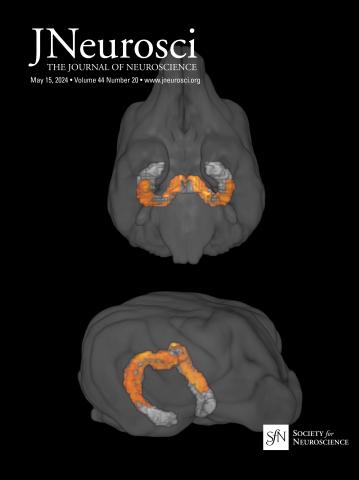Functional heterogeneity within the primate ventral striatum for motivational regulation.
IF 4.4
2区 医学
Q1 NEUROSCIENCES
引用次数: 0
Abstract
The ventral striatum (VS) is a key brain region for reward processing and motivation, and its dysfunctions have been implicated in psychiatric disorders such as apathy and obsessive-compulsive disorder. Although functional heterogeneity within the VS has been well established in rodents, its relevance and mechanisms in primates remain unclear. To address this issue, we performed bilateral pharmacological inactivation of the VS in two male macaque monkeys using muscimol, a GABAA receptor agonist. Precise targeting was achieved through computed tomography and magnetic resonance imaging. Behavioral effects were evaluated using two methods: a goal-directed task with variable rewards and analysis of spontaneous behavior. Our results demonstrated that anterior (a)VS inactivation induced a hypoactivity state that we termed "resting," whereas posterior (p)VS inactivation elicited compulsive-like "checking" behaviors. Notably, neither the aVS nor the pVS inactivation affected reward value or drive processing, thus differentiating aVS and pVS from those involved in incentive motivation, such as the rostromedial caudate and ventral pallidum. Retrograde tracing demonstrated distinct anatomical projection patterns for the aVS and pVS, supporting their functional segregation. Together, the present results suggest the functional heterogeneity of the primate VS along its anterior-posterior axis, with the aVS and pVS participating in distinct motivational control circuits. Our findings may have important implications for understanding the neural mechanisms of psychiatric disorders and for the development of new therapeutic approaches.Significance Statement The ventral striatum (VS) is a core brain region that is involved in motivation and reward-based behaviors. Its dysfunction is implicated in psychiatric disorders such as apathy and obsessive-compulsive disorder. In macaque monkeys, we used imaging-guided pharmacological manipulations to reveal that the anterior and posterior VS subregions have distinct roles in motivation, independent of the incentive or reward drive. Specifically, anterior VS inactivation induced a hypoactive state, whereas posterior VS inactivation elicited compulsive-like behaviors. These findings reveal distinct motivational mechanisms within the primate VS, thus offering valuable insights into the neural basis of psychiatric disorders and identifying promising therapeutic targets.灵长类腹侧纹状体在动机调节方面的功能异质性。
腹侧纹状体(VS)是奖赏处理和动机的关键脑区,其功能障碍与冷漠症和强迫症等精神疾病有关。虽然啮齿类动物的纹状体功能异质性已经得到了很好的证实,但其在灵长类动物中的相关性和机制仍不清楚。为了解决这个问题,我们使用 GABAA 受体激动剂 muscimol 对两只雄性猕猴的 VS 进行了双侧药理学失活。通过计算机断层扫描和磁共振成像实现了精确靶向。我们采用两种方法评估了行为效果:奖励可变的目标定向任务和自发行为分析。我们的研究结果表明,前(a)VS 失活会诱发我们称之为 "静息 "的低活动状态,而后(p)VS 失活则会诱发强迫性的 "检查 "行为。值得注意的是,aVS 和 pVS 失活都不会影响奖赏价值或驱动力处理,从而将 aVS 和 pVS 与那些参与激励动机的部位(如尾状核和苍白球腹侧)区分开来。逆行描记显示了aVS和pVS不同的解剖投射模式,支持了它们的功能分离。本研究结果表明,灵长类VS沿其前后轴线存在功能异质性,aVS和pVS参与了不同的动机控制回路。我们的发现可能对理解精神疾病的神经机制和开发新的治疗方法具有重要意义。 重要意义 声明 腹侧纹状体(VS)是大脑的核心区域,参与动机和奖赏行为。它的功能障碍与冷漠症和强迫症等精神疾病有关。在猕猴身上,我们利用成像引导的药理学操作揭示了前部和后部VS亚区在动机中的不同作用,而与激励或奖赏驱动无关。具体来说,前VS失活会诱发低活跃状态,而后VS失活则会诱发强迫行为。这些发现揭示了灵长类VS内不同的动机机制,从而为研究精神疾病的神经基础提供了有价值的见解,并确定了有希望的治疗目标。
本文章由计算机程序翻译,如有差异,请以英文原文为准。
求助全文
约1分钟内获得全文
求助全文
来源期刊

Journal of Neuroscience
医学-神经科学
CiteScore
9.30
自引率
3.80%
发文量
1164
审稿时长
12 months
期刊介绍:
JNeurosci (ISSN 0270-6474) is an official journal of the Society for Neuroscience. It is published weekly by the Society, fifty weeks a year, one volume a year. JNeurosci publishes papers on a broad range of topics of general interest to those working on the nervous system. Authors now have an Open Choice option for their published articles
 求助内容:
求助内容: 应助结果提醒方式:
应助结果提醒方式:


